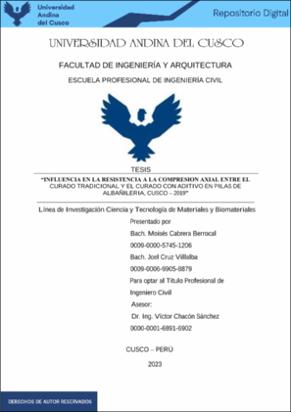| dc.contributor.advisor | Chacón Sánchez, Víctor | |
| dc.contributor.author | Cabrera Berrocal, Moisés | |
| dc.contributor.author | Cruz Villalba, Joel | |
| dc.date.accessioned | 2024-05-07T15:59:36Z | |
| dc.date.available | 2024-05-07T15:59:36Z | |
| dc.date.issued | 2021-11-19 | |
| dc.identifier.uri | https://hdl.handle.net/20.500.12557/6327 | |
| dc.description.abstract | Este estudio se realizó con el objeto de determinar la influencia en la resistencia a la compresión
axial del tipo de curado en pilas de albañilería. Se empleó el método hipotético deductivo, pues
planteamos una hipótesis general y tres sub hipótesis relacionadas con la solidez a la
compresión vertical, controlando el curado de muros pequeños. Para lo cual se construyó 15
pilas de albañilería que es la población y 5 para cada tipo de curado el cual es la muestra
(ladrillos industriales de 24 cm x 12 cm x 9 cm) y mezcla de cemento y arena en la proporción
1:4, con 1 cm. de anchura; los cuales fueron evaluados a la compresión axial. Una vez
construidos los muretes, se procedió con el curado tradicional (agua potable), a 5 pilas de
albañilería, luego a las otras 5 pilas de albañilería se les aplicó un curado con aditivo curador
(Sika Cem curador), a las 5 pilas de albañilería restantes no se les aplico ningún tipo de curado.
Seguidamente se sometió a ensayos a compresión axial a los 28 días de edad, de esta manera
determinó cómo afectó el proceso de curado al valor de la resistencia a la compresión axial de
pilas de albañilería. Finalmente, después de los ensayos se comprobó que no se incrementa la
resistencia a compresión axial con el curado con aditivo el cual es 62.55 kg/cm2, por el contrario
no llega al mínimo requerido por la NTP E-070 el cual es 65.00 kg/cm2, el curado tradicional
(agua potable) sí cumple con los parámetros de la norma E–070 e incluso supera la resistencia
exigida dando una resistencia a compresión axial de 65.16 kg/cm2, por lo cual podemos afirmar
que la técnica de curado más adecuada es la que utilizó el proceso de curado tradicional (agua
potable). | es_PE |
| dc.description.abstract | The present research work was carried out with the purpose of determining the influence of the
type of curing on the axial compressive strength of masonry piles. The hypothetical deductive
method was used since we proposed a general hypothesis and three sub-hypotheses related to
the axial compressive strength by controlling the curing of masonry piles. For which 15
masonry piles were built, which is the population and 5 masonry piles for each type of curing,
which is the sample (industrial bricks of 24 cm x 12 cm x 9 cm) and a cement-sand mortar in a
1:4 ratio, with a thickness of 1 cm; which were evaluated in axial compression. Once the
masonry piles were built, 5 masonry piles were cured with traditional curing (potable water),
then 5 other masonry piles were cured with a curing additive (Sika Cem curing), and the
remaining 5 masonry piles were not cured at all. Then they were subjected to axial compression
tests at 28 days of age, in order to determine the influence of the curing procedure on the value
of the axial compressive strength of the masonry piles. Finally, after the tests, it was verified
that the axial compressive strength does not increase with the curing with additive, which is
62.55 kg/cm2, on the contrary, it does not reach the minimum required by NTP E-070, which
is 65. 00 kg/cm2, the traditional curing (potable water) does comply with the parameters of
standard E-070 and even exceeds the required resistance, giving an axial compressive strength
of 65.16 kg/cm2, so we can affirm that the most adequate curing technique is the one that used
the traditional curing process (potable water). | en_US |
| dc.format | application/pdf | es_PE |
| dc.language.iso | spa | es_PE |
| dc.publisher | Universidad Andina del Cusco | es_PE |
| dc.rights | info:eu-repo/semantics/openAccess | es_PE |
| dc.rights.uri | https://creativecommons.org/licenses/by-nc-nd/4.0/ | es_PE |
| dc.subject | Curado | es_PE |
| dc.subject | Aditivo curador | es_PE |
| dc.subject | Resistencia a la compresión axial | es_PE |
| dc.subject | Pilas de albañilería | es_PE |
| dc.title | Influencia en la resistencia a la compresión axial entre el curado tradicional y el curado con aditivo en pilas de albañilería, Cusco – 2019 | es_PE |
| dc.type | info:eu-repo/semantics/bachelorThesis | es_PE |
| thesis.degree.name | Ingeniero Civil | es_PE |
| thesis.degree.grantor | Universidad Andina del Cusco. Facultad de Ingeniería y Arquitectura | es_PE |
| thesis.degree.discipline | Ingeniería Civil | es_PE |
| dc.publisher.country | PE | es_PE |
| dc.subject.ocde | https://purl.org/pe-repo/ocde/ford#2.01.01 | es_PE |
| renati.advisor.dni | 23807993 | |
| renati.advisor.orcid | https://orcid.org/0000-0001-6891-6902 | es_PE |
| renati.author.dni | 42587947 | |
| renati.author.dni | 40825679 | |
| renati.discipline | 732016 | es_PE |
| renati.juror | Arohuanca Sosa, Rode Luz | |
| renati.juror | Mendoza Escalante, Camilo | |
| renati.juror | Pezo Zegarra, Eliot | |
| renati.juror | Merino Yepez, Robert Milton | |
| renati.level | https://purl.org/pe-repo/renati/level#tituloProfesional | es_PE |
| renati.type | https://purl.org/pe-repo/renati/type#tesis | es_PE |
| dc.description.lineadeinvestigacion | Ciencia y Tecnología de Materiales y Biomateriales | es_PE |




